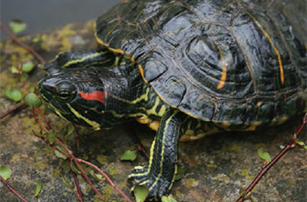| Management programme |
| Site-led (Wetlands) |
| Objective |
| Provide advice and information on red-eared sliders and reduce their impacts in wetlands within the Waikato region. |
| Impacts |
| Biodiversity, water quality/quantity, amenity/recreation |
Red-eared slider turtles get their name from the small yellow to red ‘dash’ around their ears. The ‘slider’ part of their name comes from their ability to slide off rocks and logs and into the water quickly. These turtles can live up to 50 years in captivity – but they usually live between 20 to 30 years

What does a red-eared slider look like?
Red-eared sliders are semi-aquatic turtles.
- Shell can grow up to 350mm long.
- Some individuals have been known to reach more than 400mm, but average length ranges from 120mm to 200mm.
- Females are usually a little larger than the males.
- Shell and skin are usually leaf green in young turtles, turning olive to brown in mature turtles.
- Head, legs, tail are green with fine yellow irregular lines.
Why are they a pest?
The Invasive Species Specialist Group has listed the red-eared slider turtle as one of the world’s 100 worst invasive species. It is a medium sized freshwater turtle native to southern parts of the United States. Red-eared slider turtles are readily available in New Zealand, sold through the pet trade as juveniles around 50mm long. Red-eared slider turtles are omnivorous, long lived and tolerate a range of environmental conditions.
The impact of red-eared slider turtles in the wild in New Zealand is largely unknown, but given their omnivorous diet, they could adversely impact aquatic plants, insects, eels, small fish species and ground-nesting birds. They can survive in the wild in a wide range of aquatic habitats, including manmade drains and canals, natural wetlands, rivers, lakes, ponds and brackish estuarine waters.
Overseas, wild populations have become established predominantly by people releasing pet turtles when they outgrow their tanks and outlive their appeal. With a steady supply of red-eared slider turtles from the pet trade adding to numbers already in public hands, there is potential for them to become a serious problem in some locations. Serious consideration should be undertaken before purchasing such a long-lived animal as a pet.
Red-eared slider turtles can survive in the wild in the Waikato and there are a number of areas that have proven suitable for their reproduction. Climate change could increase the number of places that are suitable for them to breed.
Responsible pet ownership
If you have an unwanted pet red-eared slider turtle, DO NOT release it into the wild. Contact your local pet shop, SPCA or a turtle rescue in the hope they may be able to rehome the turtle. If you see any red-eared slider turtles in the wild, note the exact location of the sighting and report it to Waikato Regional Council. Turtles are often sighted sunning themselves on banks or stones, or swimming in still watercourses.
More information
For advice and additional information on red-eared slider turtles, call our animal pest staff on freephone 0800 800 401.



